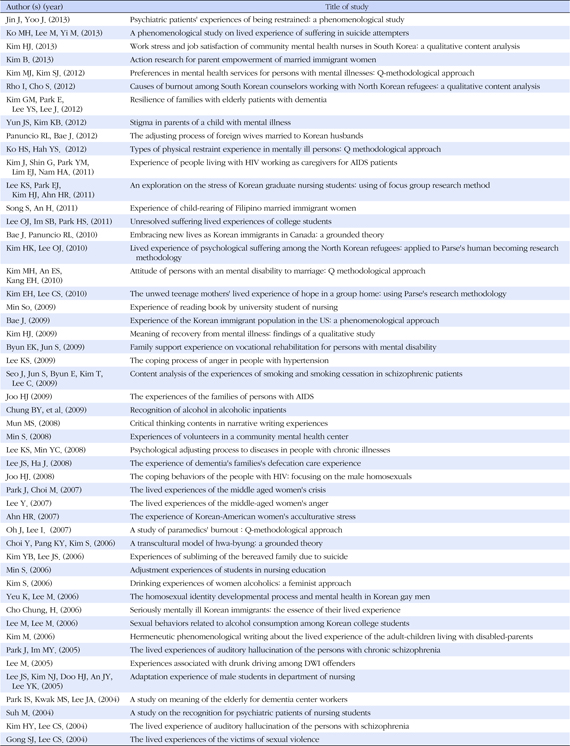Abstract
Purpose
The purpose of this study was to analyze the trends in qualitative research articles that from 2004 to 2013 in the Journal of Korean Academy of Psychiatric and Mental Health Nursing and to raise issues for the evolution of qualitative research.
Methods
Descriptive statistics and qualitative evaluation were used in analysis of fifty qualitative studies. The focus was on research methodology and techniques to establish validity of the study.
Results
Most frequently used methodological orientation was phenomenology (48.0%) and the analytic method was Colaizzi's. Nearly two-thirds of studies focused on general population or psychiatric patients dwelling in community settings. There were no comments on validity in fifteen studies, and in the rest of studies, the description about the techniques to enhance the validity of study were not elaborated.
Conclusion
Although qualitative studies in health care environment have increased recently, the proportion of qualitative studies compared with quantitative studies was relatively low in the Journal of Korean Academy of Psychiatric and Mental Health Nursing. In order to make qualitative studies useful to nursing research, practice, administration and education, authors employing qualitative research methods should exert efforts to enhance validity of studies.
Figures and Tables
References
1. Kim Y. Qualitative methodology II: methods. Seoul: Academy Press;2013. p. 679.
2. Park S. The trends of qualitative research on counseling psychology in Korea. Korean J Couns. 2012; 13(2):953–977. http://dx.doi.org/10.15703/kjc.13.2.201204.953.

3. Daly J, Willis K, Small R, Green J, Welch N, Kealy M, et al. A hierarchy of evidence for assessing qualitative health research. J Clin Epidemiol. 2007; 60(1):43–49. http://dx.doi.org/10.1016/j.jclinepi.2006.03.014.

4. Sandelowski M. Using qualitative research. Qual Health Res. 2004; 14(10):1366–1386. http://dx.doi.org/10.1177/1049732304269672.

5. Kim YK, Hwang SY, Shin SJ. Analysis of qualitative research published by Korean Journal of Adult Nursing. Korean J Adult Nurs. 2011; 23(6):633–641.
6. Na J. A comparative analysis of validity issues in qualitative research. J Educ Eval. 2006; 19(1):265–283.
7. Sandelowski M, Barroso J. Writing the proposal for a qualitative research methodology project. Qual Health Res. 2003; 13(6):781–820. http://dx.doi.org/10.1177/1049732303013006003.

8. Lee YH, Lee YM, Kwon HJ. Review: Trends analysis on research articles in the Korean Journal of Medical Education. Korean J Med Educ. 2012; 24(4):287–299. http://dx.doi.org/10.3946/kjme.2012.24.4.287.

9. Kim S, Kim SA. Phenomenological study on the work: family compatibility of dual-earner families. Fam Environ Res. 2013; 51(3):355–370. http://dx.doi.org/10.6115/fer.2013.51.3.355.

10. Kim Y. Understanding family caregivers' experiences of living with dementia: a transcendental phenomenological inquiry. J Korean Gerontol Soc. 2007; 27(4):963–986.
11. Rush P. The experience of maternal and child health nurses responding to women with postpartum depression. Matern Child Health J. 2012; 16(2):322–327. http://dx.doi.org/10.1007/s10995-010-0688-2.

12. Moustakas CE. Phenomenological research methods. Thousand Oaks: Sage Publication;1994. p. 192.
13. Lopez KA, Willis DG. Descriptive versus interpretive phenomenology: their contributions to nursing knowledge. Qual Health Res. 2004; 14(5):726–735. http://dx.doi.org/10.1177/1049732304263638.

14. Creswell JW. Qualitative inquiry and research design. 3rd ed. Thousand Oaks: Sage Publication;2012. p. 448.
16. Miles MB, Huberman AM. Qualitative data analysis. Thousand Oaks: Sage Publication;1994. p. 338.
17. Stenner P, Rogers RS. Q methodology and qualiquantology. In : Todd Z, Nerlich B, McKeon S, Clarke DD, editors. Mixing methods in psychology: the integration of qualitative and quantitative methods of theory and practice. New York: Psychology Press;2004. p. 251.
18. Boyatzis RE. Transforming qualitative information: thematic analysis and code development. Thousand Oaks: Sage Publication;1998. p. 184.
19. Kim H. Q methodology: philosophy, analysis, and application. Seoul: Communication Books;2008. p. 499.
20. Lim S. An analysis of qualitative research methods used in articles published in the Journal of Korean Sociology of Sport. J Korean Soc Sports. 2004; 17(3):253–267.
21. Morse JM, Barrett M, Mayan M, Olson K, Spiers J. Verification strategies for establishing reliability and validity in qualitative research. Int J Qual Methods. 2002; 1(2):13–22. Available from: http://ejournals.library.ualberta.ca/index.php/IJQM/article/view/4603/3756.

22. Lincoln YS, Guba EG. Naturalistic inquiry. Newbury Park: Sage Publication;1985. p. 416.
23. Guba EG, Lincoln YS. Forth generation evaluation. Newbury Park: Sage Publication;1989. p. 294.
24. Moerer-Urdahl T, Creswell JW. Using transcendental phenomenology to explore the "ripple effect" in a leadership mentoring program. Int J Qual Methods. 2004; 3(2):19–35. Available from: http://ejournals.library.ualberta.ca/index.php/IJQM/article/view/4470/3594.





 PDF
PDF ePub
ePub Citation
Citation Print
Print







 XML Download
XML Download